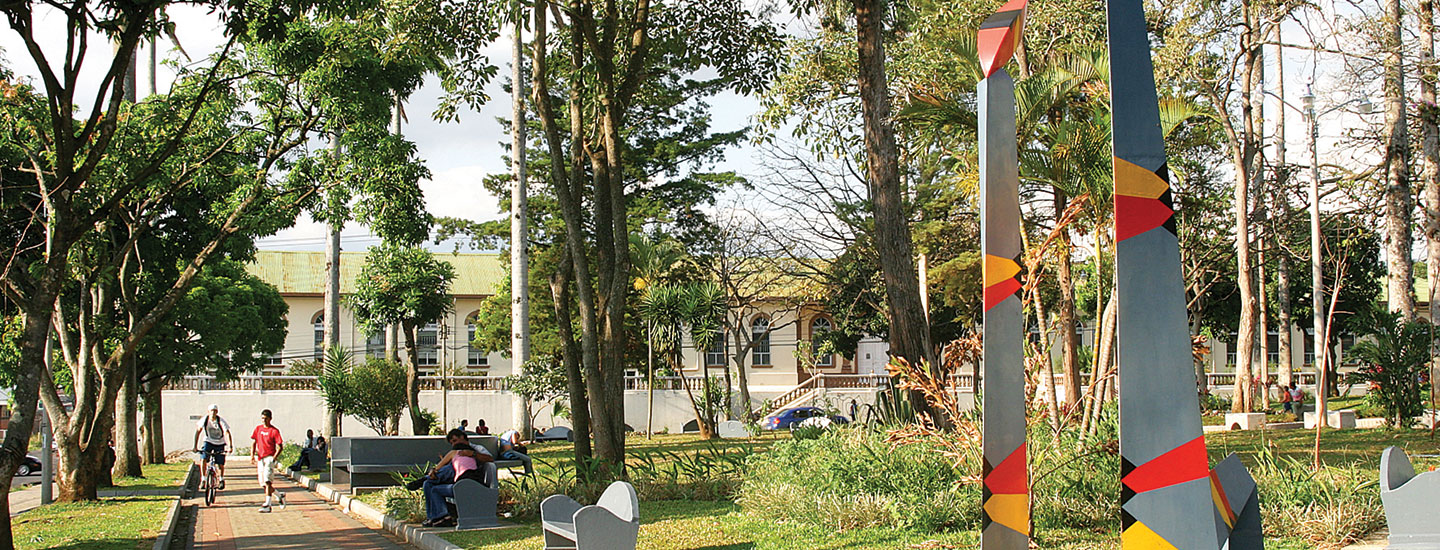Alajuela Cathedral
Next to Alajuela Park is the Cathedral, which began as a public prayer building in 1782. Its construction was finished in 1863 and was declared as a cathedral in 1921.
Its neoclassical style and proximity to the park and downtown Alajuela give the area an elegant, but simple character, typical of the Alajuelan town. In the rear of the cathedral is the reddish dome, also designed in the neoclassical style.
Its interior has a simple and spacious decoration, with the exception of the dome, which has more ornamentation. Made up of three naves, the capitals are decorated with motifs from the local area.
Methodist Church
This building makes up part of the historical center of the city and is considered an extremely valuable landmark. The presence of the Methodist congregation in Costa Rica dates back to 1917 and in 1928 the first Methodist church “El Mesias” was built in brick in the center of the city, which still stands as a traditional meeting point for the Methodist community.
Juan Santamaria History Museum
This fortress was built between 1874 and 1877 by General Tomas Guardia and was remodeled in 1936 by then-president Leon Cortes Castro. Various Alajuelan military leaders that commanded the headquarters came to be president of the republic such as General Prospero Fernandez and General Bernardo Soto Alfaro.
By 1894 there were enough military weapons to arm 5,000 men. Some believe that the underground tunnels that connect the barracks with the general’s residence and the city hall are from the remodeling in 1936.
After the abolition of the military, it was converted into an education center and after that, it was the main office for the Research and Perfection in Technical Learning Center (CIPET in Spanish). It has been recently set up as the Juan Santamaria History and Culture Museum. It was declared a historical architectural point of interest, according to the Executive Decree published in the La Gaceta.
San Rafael Hospital
Construction on the historic San Rafael Hospital was completed in 1905. The eclectic baroque design of its southern facade is still almost completely intact and it was declared a historical architectural heritage site by Executive Decree on September 3, 1999, and published in La Gaceta.
The southern facade of the property joins the Palmares Park in historical-architectural harmony. For more than 100 years, this hospital center has served the needs of the Alajuelan community, making it an important institution within the historical development of the community. It is currently home to the Costa Rica Social Security offices.
Ascencion Esquivel School
The Ascencion Esquivel Ibarra School is another valuable national and tourism site. It is a concrete building dating back to 1936. It was designed and supervised by the architect Jose Maria Barrantes, one of the most renowned architects of public and private buildings in the middle of the 20th century. It is part of the historical center of Alajuela and plays an important role in the urban life of the city.
Alejandro Morera Soto Stadium
The Alejandro Morera Soto stadium is close to the historical center of Alajuela. It is home to the Liga Deportiva Alajuelense, one of the football clubs with the longest running traditions in Costa Rica and in Central America, founded on June 18, 1919.
With a collection of 27 national championships and 17 runner-up titles past football greats have passed through this club, including the best football player in the history of Costa Rica, the great magician of the soccer ball, Alejandro Morera Soto, the name given to the stadium in 1961.
The Conception of the Plains Chapel
The chapel was built at the end of the 19th century in 1889. The adobe wattle and daub construction system used build this temple is nowadays obsolete, making it one of the few religious buildings representing this style.
This property is the result of hardworking local management, which was able to acquire the land and finance it by means of social and recreational activities.
The combination of the former considerations is sufficient grounds to ensure its conservation and grant it historical and architectural heritage site status.
Public Displays of Art
In order to promote culture and create a sense of belonging among Alajuelans to strengthen local identity, the City of Alajuela has created the “Public Art Displays” project which is a contest to select various works of art to be displayed throughout the downtown Alajuela and surrounding areas.

